Introduction
Antidepressants drugs are generally used in the psychiatric medication for alleviating the mood disorders. These disorders entail depression or dysthymia. Originally, the chemical classes of the analyzed drugs, such as Fluoxetine C17H18F3NO, Venlafaxine, C17H27NO2, Bupropion C13H18ClNO, Amitriptyline C20H23N, Phenelzine C8H12N2, Carbamazepine C15H12N2O, will be evaluated in accordance with various aspects and characteristics, such as structural analysis, acid-base characteristics, ionization processes, polarity, solubility, partition and the theoretical metabolic pathways. Nevertheless, it should be stated that some of the enlisted drugs have not been properly studies, thus, only studied characteristics will be given.
Class of the Drugs
The fact is that, the classes of the antidepressants differ in accordance with the factor which brain or neural component they affect, and the way they affect it.
In order to understand the principles of chemical action of the medications analyzed, the principles, in accordance to which these drugs are classified will be explained.
Selective serotonin reuptake inhibitors (SSRIs). These are the antidepressants, which are considered to be the classical treatment approach. While inadequate amount of serotonin is regarded to be a possible cause of depression is an inadequate amount of serotonin, these medications are intended to change this amount. Joseph and Wroblewski (2001, p. 341) emphasize that “SSRIs are aimed to prevent the process of serotonin reuptake (also known as 5-hydroxytryptamine, or 5-HT) by the presynaptic neuron, thus maintaining higher levels of 5-HT in the synapse”
Serotonin-norepinephrine reuptake inhibitors (SNRIs). These are the newer form of antidepressant that are based on both the principle of serotonin reuptake prevention and norepinephrine action.
Norepinephrine-dopamine reuptake inhibitors (NDRI). This class of antidepressants inhibit the neuronal reuptake of dopamine and norepinephrine (noradrenaline) (Herman, 2004)
Tricyclic antidepressants (TCA). These are the oldest and the most traditional class of remedies. They block the reuptake of neurotransmitters such as norepinephrine (noradrenaline) and serotonin. As Herman (2004, p. 67) claims: “Tetracyclic antidepressants are based on the principle of preventing the chemicals from attaching to the nerve cell receptors so that levels of norepinephrine and serotonin are increased”.
Monoamine oxidase inhibitors (MAOIs). They are used if other classes appeared to be ineffective, as their aim is to prevent the breakdown of monoamine neurotransmitters, thus, increasing their activity, which may be fatal if proper diet is not observed.
Anticonvulsants, in accordance with Reinhard, Whyte and Sandel (2002), are the most aggressive, as they suppress the rapid and excessive firing of neurons that start a seizure. They also prevent the spread of the seizure within the brain and offer protection against possible excitotoxic effects that may result in brain damage.
Absorption and Metabolism Factors
The following table represents the values of the reuptake of serotonin and the affinity of the drugs to various receptors.
- SERT – Serotonin transporter
- NET – Norepinephrine transporter
- DOP ‑ Dopamine transporter
- H1 – Histamine H1 receptor
- M1-5 ‑ Muscarinic acetylcholine receptor
- α1 ‑ Alpha-1 adrenergic receptor
- α2 ‑ Alpha-2 adrenergic receptor
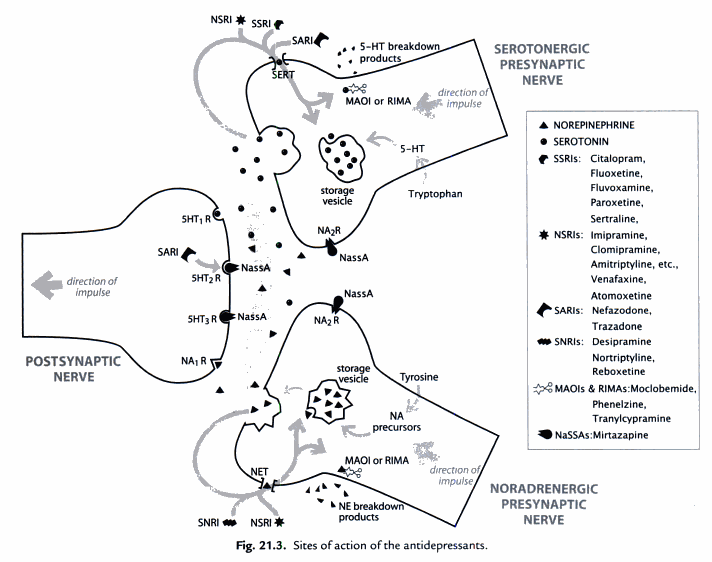
As it is stated in Foye (2008, p. 554):
The key step, which generally defines the intensity and duration of monoamine signaling at synapses is the reuptake of the released neurotransmitter into nerve terminals through high-affinity plasma membrane transporters. Reuptake is the process of rapidly removing the monoamine neurotransmitters from the synaptic cleft and allowing most of the released neurotransmitter to be recycled for further use. Thus, the faster diffusion into the membrane is observable, as any monoamine neurotransmitter remaining in the synaptic cleft is then absorbed and metabolized into inactive metabolites.
The allover reuptake process, which is crucial for the effective action of these drugs is the process when an impulse is going through a nerve, thus, causing a cell to release serotonin or norepinephrine, which enter the gap between the contacting nerve cells. When this amount reaches certain level, the impulse continues its way. Then, the remaining serotonin or norepinephrine is absorbed by the cells. This is called the reuptake.
The fact is that, serotonin is considered to be not the only chemical component that causes depression. In accordance with the contemporary trends of neurochemistry, lack of or norardrenaline may also cause depression. Thus, the newest tendency within the antidepressants is the increase of the brain’s supply of dopamine or norepinephrine.
Assuming the calculations antidepressants are considered to be more basic due to the existence of two adjacent ER methyl groups compared to the adjacent one methyl. Nevertheless, Venlafaxine, has a low pKa value of 6 which may be attributed to sp2 hybridization of the H atom.
Fluoxetine
C17H18F3NO
Mol. Mass ‑ 309.3 g/mol (345.8 for HCl)
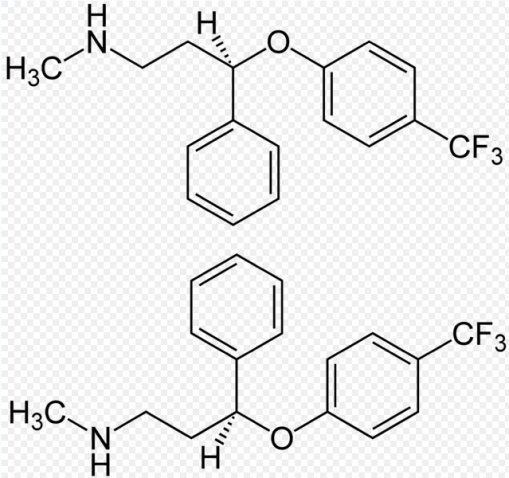
The metabolism process is observed mainly in the liver. P-450 enzymes take the important part in the metabolism, increasing the absorption. It should be stated that it is bound to plasma protein, thus, the overdose may cause a shift in plasma concentrations, and lead to the adverse effect.
As for the matters of optical isomerism Leucht and Heinamann (2006, p346) give the following information:
Chemically, this isomer of the active fluoxetine components is (-)-2-(tertbutylamino)-3′-chloropropiophenone or (-)-1-(3-chlorophenyl)-2[(1,1-dimethyl-ethyl)amino]-1-propanone. This isomer is also includes the substantially optically pure (-)-bupropion isomer. The saturation data is suggestive of a two-site receptor model incorporating a high-affinity site (Kh of 0.3–0.5 nM) corresponding to the 5-HT1A receptor, and a low-affinity site (Kl ofca 25 nM). After in vivo alkylations, carried out by treating rats withN-ethoxycarbonyl-2-ethoxy-1,2-dihydro-quinoline (EEDQ), the saturation curves from both control and EEDQ-treated rats were again best fitted to a two-site model.
Venlafaxine
C17H27NO2
Mol. mass 277.402 g/mol
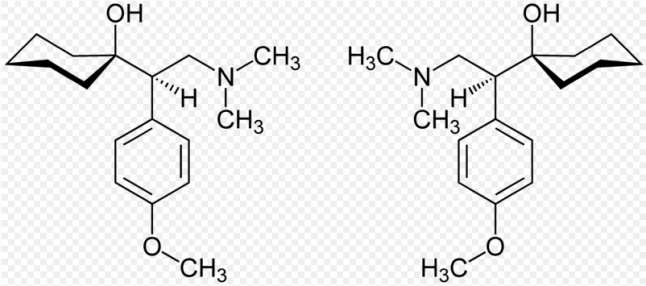
It is metabolized in the liver with the active participation of P-450 enzym.
“The o-desmethyl metabolite is active but is conjugated with glucuronic acid and excreted. Venlafaxine is structurally and pharmacologically related to the atypical opioid analgesic.” (Joseph, Wroblewski, 2001, p. 94) It is not studied properly, thus, the data on optical isomerism and alkylation is not available.
Bupropion
C13H18ClNO
Mol. mass 239.74 g/mol

As the medicine related to the Norepinephrine-Dopamine Reuptake Inhibitor, Bupropion is also regarded as an α3β4 nicotinic antagonist. As Herman (2004, p 179) emphasizes: “The degree of inhibition of α3β4 receptors correlates well with the decrease in self-administration of morphine and methamphetamine, and may be relevant to the effect of Bupropion on nicotine addiction”, thus, Bupropion may be classified as an aggressive antidepressant. The fact is that, the mechanism of action of this drug is not understood clearly. It is considered that its main aim is to inhibit the reuptake of norepinephrine and the absorption of dopamine.
Amitriptyline
C20H23N
Mol. mass 277.403 g/mol
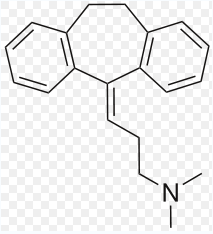
Cyclic Hydrocarbons, Polycyclic Compounds
Amitriptyline exposure evoked the strongest global chromatin modifications, including histone H3/H4 hyperacetylation, 2MeH3K9 hypomethylation, and DNA demethylation. CpG demethylation occurred independently of DNA methyltransferase (DNMT) suppression. Locally, chromatin modifications are reflected at the glutamate transporter (GLT-1) Distinct CpG sites in the distal part of the GLT-1 promoter were demethylated and enriched in acetylated histone H4 in response to VPA.
As for the optical isomerism, it should be stated that comparing S and R enatiomers, it was found that escitalopram is 30 times more powerful inhibitor of serotonin reuptake than its optical antipode. Moreover, because of the differences in the allocation of isomers in the organism, the real value of escitalopram, is no more than 35%. Consequently, there is strong necessity to increase the consumption of SSRI, if citalopram is changed for escitalopram. Nevertheless, it should be considered that amitriptyline entails enantiomer, and, optical features of this drug are close to Fluoxetine.
Phenelzine
C8H12N2
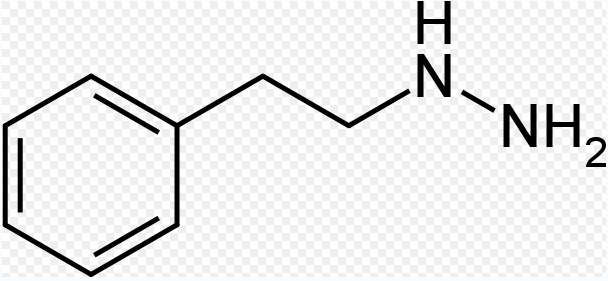
The molecules of Phenelzine are subject to ionization since the tertiary amine group can be ionized when reacting with water by forming a quaternary amine salt with a positive charge. Obviously the drugs with the highest pKa value would be the strongest bases and more prone to ionization.
Carbamazepine
C15H12N2O
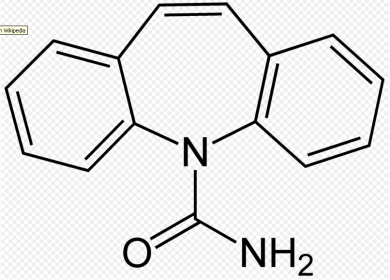
The interaction between Human Serum Albumin (HSA) and Carbamazepine have been researched with different spectroscopic techniques. Originally, these are the fluorescence, UV–visualized absorption, circular dichroism and FTIR under simulated physiological conditions. Thus, the optical isomerism may be featured with the fluorescence results, which revealed the static type of quenching mechanism in the binding. As Reinhard, Whyte and Sandel (2002, p. 83) emphasize:
The values of binding constant, K of Carbamazepine and HSA were evaluated at 289, 300 and 310 K and were found to be 1.90 × 103, 1.68 × 103 and 1.45 × 103 M−1, respectively. The number of binding sites, n was noticed to be almost equal to unity thereby indicating the presence of a single class of binding site for Carbamazepine on HSA. Based on the thermodynamic parameters, ΔH0 and ΔS0 nature of binding forces operating between HSA and Carbamazepine were proposed. Spectral results revealed the conformational changes in protein upon interaction.
Reference List
Foye, W. O., Lemke, T.L., Williams, D.A. (2008) “Foye’s principles of medicinal chemistry” Lippincott Williams & Wilkins
Herman, C.D. (2004). Abstract: The incidence of seizures during tricyclic antidepressant drug treatment in a brain-injured population.Journal of Head Trauma Rehabilitation. 6(4), 67-68.
Joseph, A.B. & Wroblewski, B. (2001). Depression, antidepressants, and traumatic brain injury.Journal of Head Trauma Rehabilitation. 10(2), 90-95.
Leucht S, Heinamann J, (2006) “New generation antidepressants: a systematic review and meta-analysis” Lancet; 341: 1321-7
Reinhard, D., Whyte, J., Sandel, E. (2002). Improved arousal and inititation following tricyclic antidepressant use in severe brain injury. Archives of Physical Medicine and Rehabilitation. 77(1), 80-83.